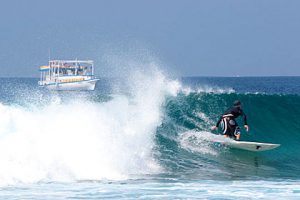Maldives is one of best surfing location in an Indian Ocean. The perfect period surfers enjoy their trip in Maldives is from March to October of every year. During this period, the roaring forties cause storms which bring the largest swells to the archipelago. The biggest waves are likely to arise in June, July and August. In this period, the wind is mainly offshore all day long. These islands are exposed to the same swells as Indonesia is, except that its higher latitude and its South-East exposure offers cooler and less hardcore surfing. The typical Maldivian wave rolls up like most point breaks with workable corners, fun pockets and long rides. Very rarely will the sets wall up or close out the channels. The waves break on mostly dead reef, and very rarely will you come in contact with it unless you are surfing on a very low tide.
Surfing in the Maldives is tempered by the North-East and South-West monsoons. During the North-East monsoon (from March until April), conditions are finest in the Southern Atolls. From May to October, during the South-West monsoon, the best surfing area is in the Northern atolls or the Central atolls. A Maldives surfing charter is one of the best ways to experience the many different waves and breaks. If you have any questions regarding our charter boats, what is included on the surf trip, or any other questions regarding the Maldives surfing experience, please feel free to contact us.
The Maldives in recent years has attracted professional surfers. Maldives has hosted international surfing competitions which put her as a world surfing destination.
Surfing areas and conditions
Dhonveli Beach and Spa fomerly Thari Village, is reputed to be the best surf stop-over in the Maldives. The resort has access to two of the best surfs in North Male. Surfers are given accommodation at Dhonveli Beach and Spa itself and in the nearby resorts.
If you want to surf outside of North Male’ atoll, you will have to book a reservation on a live aboard.
Pasta Point, is a long peeling left with exclusive access to Thari Village. Five miles away you find the Honkys and Sultans. Honkys is a long wrapping left and is reputed to be the best wave in the Maldives. Sultans is a right with barrels.
The average size of reef breakers is 4-5 feet, rising to 8-10 feet during the surf monsoon
Following are the some of famous surf points in the Maldives:
Chickens
Villingilimathi Huraa (Kuda Villingili), Uninhabited island. Eastern reef of North Male’ Atoll.
Cokes
Thulusdhoo, Atoll Capital. Eastern reef of North Male’ Atoll.
Gurus
Male’, the capital. Eastern reef of Male’, Southern tip of North Male’ Atoll.
Honky’s
Thamburudhoo (Uninhabited Island), Eastern Reef of North Male’ Atoll.
Kate’s
Boduhuraa, Uninhabited Island near the Palm Tree Island Resort. Eastern Reef of South Male’ Atoll.
Lohis
Lohifushi Island Resort. Eastern reef of North Male’ Atoll.
Male’ Island Point
Full Moon Beach Resort, Furana Fushi Island, Eastern Reef of North Male’ Atoll.
Natives
Kandooma Resort, Eastern Reef of North Male’ Atoll.
Piddlies / Ninjas
Kanifinolhu Resort. Eastern Reef of North Male’ Atoll.
Quarters
Gulhigaathuhuraa, uninhabited island attached to Palm Tree Island Resort.
Riptides
Guraidhoo, Inhabited Island. Eastern Reef of South Male’ Atoll.
Sultans
Tari Village Resort (Kanu Huraa) . Eastern reef of North Male’ Atoll.
Tomb Stones
Thamburudhoo (Uninhabited Island), Adjacent to ‘Sultans’. Eastern Reef of North Male’ Atoll.
Twin Peaks
Miyaru Faru near the island of Gulhi, inhabited island, Eastern Reef of South Male’ Atoll.